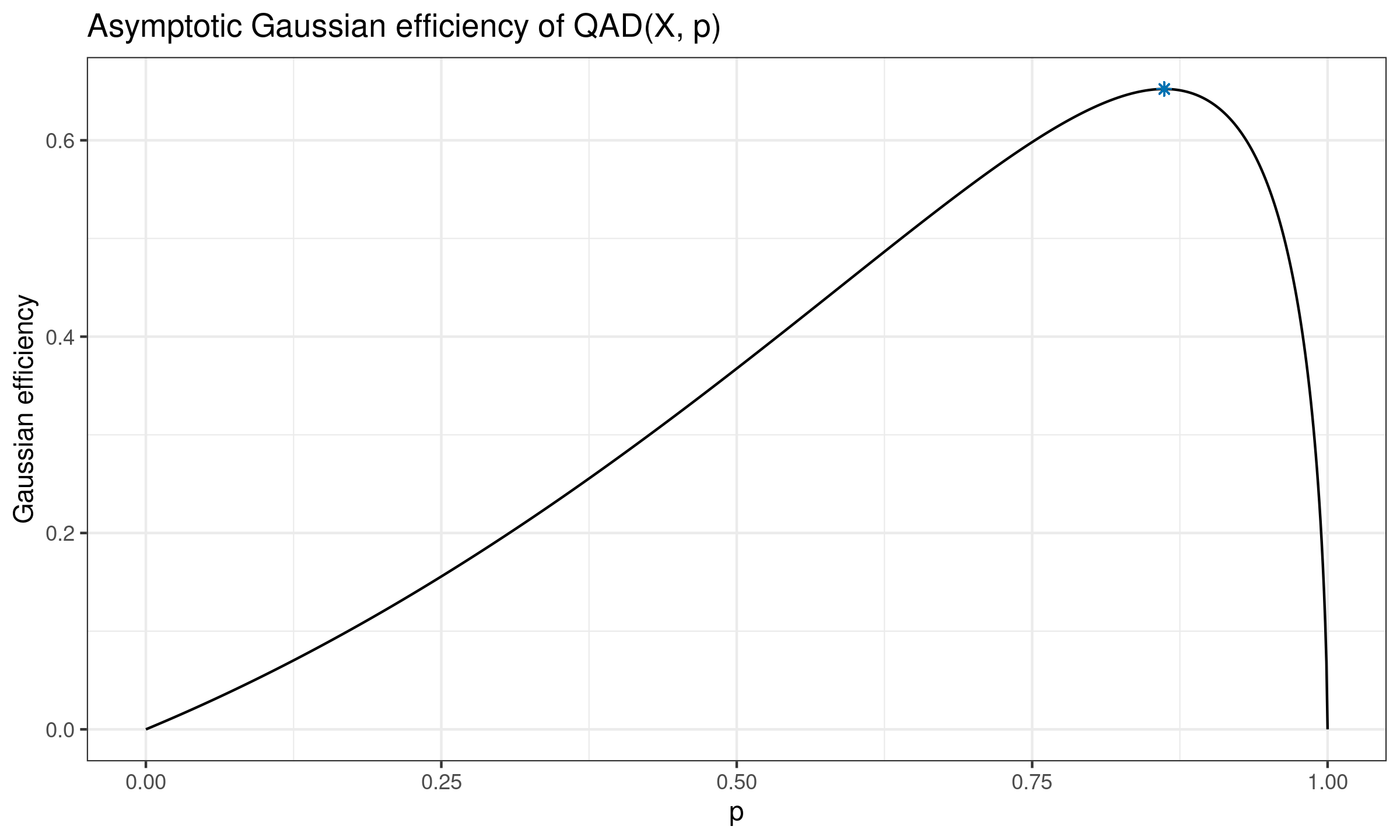Optimal quantile absolute deviation
The below text contains an intermediate snapshot of the research and is preserved for historical purposes.
We consider the quantile absolute deviation around the median defined as follows:
$$ \newcommand{\E}{\mathbb{E}} \newcommand{\PR}{\mathbb{P}} \newcommand{\Q}{\operatorname{Q}} \newcommand{\OQAD}{\operatorname{OQAD}} \newcommand{\QAD}{\operatorname{QAD}} \newcommand{\median}{\operatorname{median}} \newcommand{\Exp}{\operatorname{Exp}} \newcommand{\SD}{\operatorname{SD}} \newcommand{\V}{\mathbb{V}} \QAD(X, p) = K_p \Q(|X - \median(X)|, p), $$where $\Q$ is a quantile estimator, and $K_p$ is a scale constant which we use to make $\QAD(X, p)$ an asymptotically consistent estimator for the standard deviation under the normal distribution.
In this post, we get the exact values of the $K_p$ values, derive the corresponding equation for the asymptotic Gaussian efficiency of $\QAD(X, p)$, and find the point in which $\QAD(X, p)$ achieves the highest Gaussian efficiency.
Asymptotic consistency constants for QAD
Let us assume that $X$ follows the standard normal distribution $\mathcal{N}(0, 1)$. Since we want to achieve $\lim_{n \to \infty} \E[\QAD(X, p)] = 1$, we have
$$ \lim_{n \to \infty} \E[\QAD(X, p)] = \frac{1}{K_p}. $$Using the exact equation for the $\QAD(X, p)$ of the normal distribution, we get the exact value for the asymptotic consisency constant value:
$$ K_p = \dfrac{1}{\Phi^{-1}((p+1)/2)}. $$Asymptotic Gaussian efficiency of QAD
In this section, we consider the asymptotic relative statistical efficiency of the $\QAD$ against the standard deviation under the normal distribution (Gaussian efficiency).
We have already derived the equation for the Gaussian efficiency in the non-scaled case. Using the value of $K_p$, it is easy to update the obtained equation for the scaled case:
$$ \begin{split} \lim_{n \to \infty} e(\QAD_n(X, p),\; \SD_n(X)) = \lim_{n \to \infty} \frac{\V[\SD_n(X)]}{\V[\QAD_n(X, p)]} = \\ = \Bigg( \frac{1}{\big(\Phi^{-1}((p+1)/2)\big)^2} \pi p(1-p) \exp\Big(\big(\Phi^{-1}((p+1)/2)\big)^2 \Big) \Bigg)^{-1} = \\ = \frac{\big(\Phi^{-1}((p+1)/2)\big)^2}{\pi p(1-p) \exp\Big(\big(\Phi^{-1}((p+1)/2)\big)^2 \Big)}. \end{split} $$Here is the corresponding plot:
We can see that the presented function is unimodal with a single maximum point. Let us denote the location of this point as $\rho_o$. This value can be obtained numerically:
$$ \rho_o \approx 0.861678977787423 \approx 86.17\%. $$Optimal quantile absolute deviation
We define the optimal quantile absolute deviation by $\OQAD(X) = QAD(X, \rho_o)$. It can be interested to consider this measure of dispersion since it gives the highest Gaussian efficiency across all $\QAD(X, p)$ estimators ($65.22\%$). The corresponding breakdown point is $1 - \rho_o \approx 13.83\%$.

